![]()
![]()
![]()
Use LEFT and RIGHT arrow keys to navigate between flashcards;
Use UP and DOWN arrow keys to flip the card;
H to show hint;
A reads text to speech;
30 Cards in this Set
- Front
- Back
|
Early Netherlandish(Country)(Paintings) |
Flanders; Oil |
|
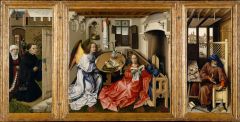
(Name of piece,artist,time period, country,importance) |
The Merode Alterpiece Robert Campin Early Netherlandish After 1422, likely between 1425 and 1428. The middle represents mary's impregnation (vase:virginity, bench with lion cloth : seat of wisdom) right side represents saint joseph (carpenter making a mouse trap (jesus trap). |
|
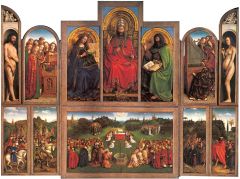
(Name of piece,artist,time period, country,importance) |
Gent Alterpiece Hubert Van Eyck Early Flemish (Netherlandish) 6 May 1432 It was designed for the chapel he and his wife acted as benefactors for, today's Saint Bavo Cathedral, at the time the parochial church of John the Baptist |
|
|
Engaging in free thinking and desire to learn and grow , artist as an individual was recognized and had self worth not just a slave for the church |
humanism |
|
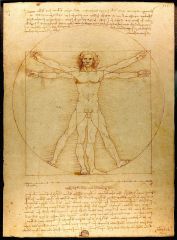
|
Vertruvian Man(Universal Man) Leonardo Da Vinci Early Renaissance Italian 1490 The drawing is based on the correlations of ideal human proportions with geometry described by the ancient Roman architect Vitruvius |
|
|
_________________ is a mathematical system for creating the illusion of space and distance on a flat surface. Who rediscovered it and when and with what |
Linear Perspective Brunalesci 1420 with the Baptistry Painting (with a hole and a mirror) |
|
|
was the most important early Renaissance sculptor from Florence. He studied classical sculpture, and used this to develop a fully Renaissance style in sculpture, which his periods in Rome, Padua and Siena introduced to other parts of Italy over his long and productive career. |
Donatello |
|
|
was Duke of Milan from 1494 until 1499, He was famed as a patron of Leonardo da Vinci and other artists, and presided over the final and most productive stage of the Milanese Renaissance. He is probably best known as the man who commissioned The Last Supper. |
Ludovico Sforza (Duke of Milan) |
|

|
St Mark. Donatello Early Renaissance Florence( Orsanmichele church) Donatello's sculpture is notable for its detailed realism, evidence of the artist's skills. Even the veins of St. Mark's left hand are visible as he holds a text upon his hip. The contrapposto pose, or natural pose, is used with Donatello's St. Mark. The saint has more weight on his left leg, his left knee is bent, and his torso is slightly twisted. |
|
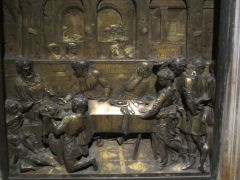
|
Feast of Herod Donatello Florence Early Renaisssance It appears on the baptistry of the Siena Cathedral in Italy. It is one of Donatello's earliest relief sculptures.[1] The sculpture is noted for Donatello's use ofperspective.[2] The piece is 60 by 60 centimeters.The sculpture depicts the beheading of John the Baptist after Salome asks Herod Antipas for his head on a platter. The scene depicts an executioner presenting the severed head, and Herod reacting in shock.See also[edit] |
|

|
David Donatello Florence(1430) Early Renaissance Sculpture represents David vs. Goliath slaying. |
|
|
___________ was the first great Italian painter of the Quattrocento period of the Italian Renaissance. According to Vasari, _________ was the best painter of his generation because of his skill at recreating lifelike figures and movements as well as a convincing sense of three-dimensionality. |
Massaccio |
|
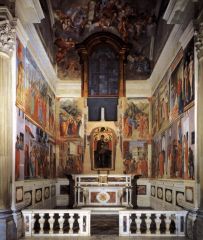
|
Brancacci Chapel is a chapel in the Church of Santa Maria del Carmine in Florence commisioned by brancacci , designed by brunalesci) Masaccio's application of scientific perspective, unified lighting, use of chiaroscuro and skill in rendering the figures naturalistically established new traditions in Renaissance Florence that some scholars credit with helping to found the new Renaissance style. |
|
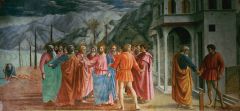
|
Tribute Money Massacio Early Renaissance (Italy)(1420) located in the Brancacci Chapel The painting is part of a cycle on the life of Saint Peter, and describes a scene from the Gospel of Matthew, in which Jesus directs Peter to find a coin in the mouth of a fish in order to pay the temple tax. It owes its importance in particular to its revolutionary use of perspective and chiaroscuro. |
|
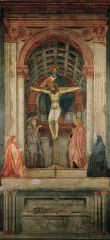
|
Holy Trinity Massacio Early Renaissance (italy) (1425-27) Santa Maria Novella church , Florence The Trinity is noteworthy for its inspiration taken from ancient Roman triumphal arches and the strict adherence to recently developed perspective techniques, with avanishing point at the viewer's eye level, so that, as Vasari describes it[3]"a barrel vault drawn in perspective, and divided into squares with rosettes that diminish and are foreshortened so well that there seems to be a hole in the wall. |
|
|
was an Italian Renaissance painter from Florence. AKA the teacher of michelangelo |
Dominico Ghirlandaio |
|
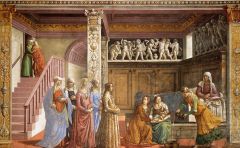
|
Birth of a virgin Dominico Ghirlandaio Florence Among the many lovely aspects of the life of the Virgin, the loveliest is the story of her conception, born of a kiss between the aged Joachim and the long-barren Saint Ann, as they linger by the city gate. Ghirlandaio places this close encounter of the Biblical kind at the top of a staircase inside what appears to be a contemporary Florentine palace |
|
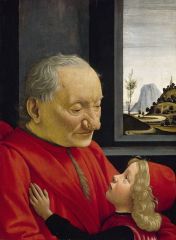
|
Old Man and his Grandson Dominico Ghirlandaio Early Renaissance (Florence) The painting depicts a moment of intimacy between an old man and a child, underscored by the placement of the child's hand on the man's chest, and the man's gentle expression. This show of affection endows the picture with emotional qualities beyond those expected from a traditional dynastic portrait. |
|
|
the treatment of light and shade in drawing and painting |
chiaroscuro |
|
|
the technique of allowing tones and colors to shade gradually into one another, producing softened outlines or hazy forms |
sfumato |
|
|
___________________ of ancient Athens pertains to the standard of excellence proposed by the cultures of ancient Greece and Rome, beginning in the Golden Age of Greece. The ancient Greeks aspired to perfection in both body and mind, and sought a synthesis of the two poles of passion and reason. Through athletic behaviour, they were able to exercise the value of perfection of body. |
Classical Ideal |
|
|
efers to the sense of distribution of perceived visual weights that offset one another. |
Balance |
|
|
s the representation of the essence of an object's or figure's position |
Gesture |
|
|
was an Italian sculptor, painter, architect, poet, and engineer of the High Renaissance who exerted an unparalleled influence on the development of Western art.[1] Considered as the greatest living artist in his lifetime, he has since been held as one of the greatest artists of all time. |
Michelangelo di Lodovico Buonarroti Simoni (6 March 1475 – 18 February 1564) |
|
|
was an Italian humanist author, artist, architect, poet, priest,linguist, philosopher and cryptographer; he epitomised the Renaissance Man. |
Leonbattista Alberti |
|
|
is a church in the Italian city of Florence. The building was constructed on the site of the kitchen garden of the monastery of San Michele, which is now gone. Reflects the strong presence of guilds |
Orsanmichele |
|
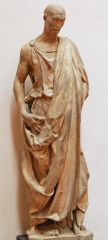
|
Zuccone Donatello Florence (Cathedral (1423-25)) as many believe it depicts the Biblical figure Habakkuk.The statue is known for its realism and naturalism, which differed from most statuary commissioned at the time. |
|
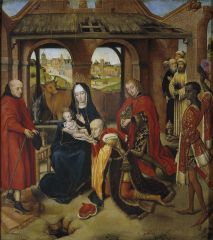
|
Adoration of the Magi Leonardo Da vinci The Virgin Mary and Child are depicted in the foreground and form a triangular shape with the Magi kneeling in adoration. Behind them is a semicircle of accompanying figures, including what may be a self-portrait of the young Leonardo (on the far right). In the background on the left is the ruin of a pagan building, on which workmen can be seen, apparently repairing it. On the right are men on horseback fighting, and a sketch of a rocky landscape. |
|
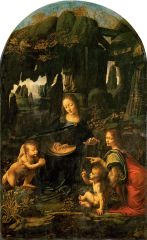
|
Madonna of the Rocks Da Vinci High Renaissance Italy Both paintings show the Madonna and Child Jesus with the infant John the Baptist and an angel, in a rocky setting which gives the paintings their usual name. The significant compositional differences are in the gaze and right hand of the angel. There are many minor ways in which the works differ, including the colours, the lighting, the flora, and the way in which sfumato has been used. |
|
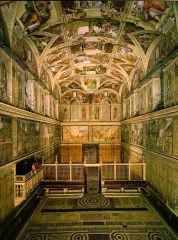
|
Sistine Chapel Between 1508 and 1512 Michelangelo a masterpiece without precedent, that was to change the course of Western art. he returned and between 1535 and 1541, painted The Last Judgement |

